Ignored Opinions: Villager-Satisfaction-Based Evaluation Method of Tourism Village Development—A Case Study of Two Villages in China
Abstract
:1. Introduction
1.1. Background
1.2. Research Question
2. Literature Review
2.1. Tourism as a Catalyst for Sustainable Development in Traditional Villages
2.2. Rural Community and Tourism Development
2.3. Village Satisfaction and Tourism Village Development Evaluation Method
3. Materials and Methods
3.1. Determination of the Experimental Subjects
3.1.1. The Jiufeng Mountain Area in Northeastern Fujian, China
- The region is a typical remote mountainous area with rolling terrain, dense forests, and an extensive network of waterways. Due to the transportation difficulties, it has experienced the impact of rapid urbanization in China to a lesser degree and in a more delayed manner. Like most mountainous areas, the traditional settlement patterns and architecture were preserved and have become valuable tourism resources in the present.
- With the development of rural tourism, villages in this region have become popular tourist destinations for surrounding cities, thanks to their beautiful natural landscapes and well-preserved traditional features. Pingnan County, as an epitome of tourism village development in Fujian Province, was successfully transformed from an impoverished county into a trending tourist destination. By 2022, Pingnan County, as a small county with a permanent population of only 139,000 inhabitants, built 16 “Gold Medal Tourist Villages” and welcomed 4.9 million tourists and earned CNY 4.05 billion (CNY 1 is approximately equal to USD 0.14 (based on exchange rates in September 2023)) of tourism income in that year.
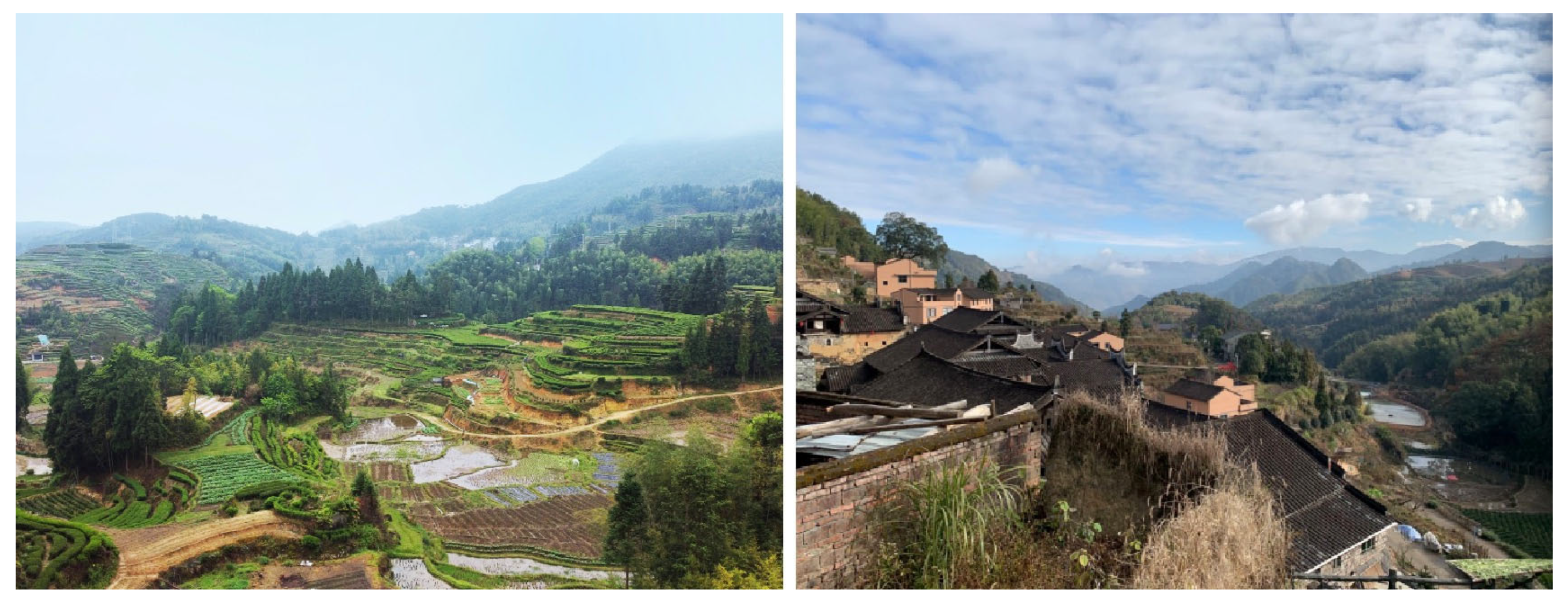

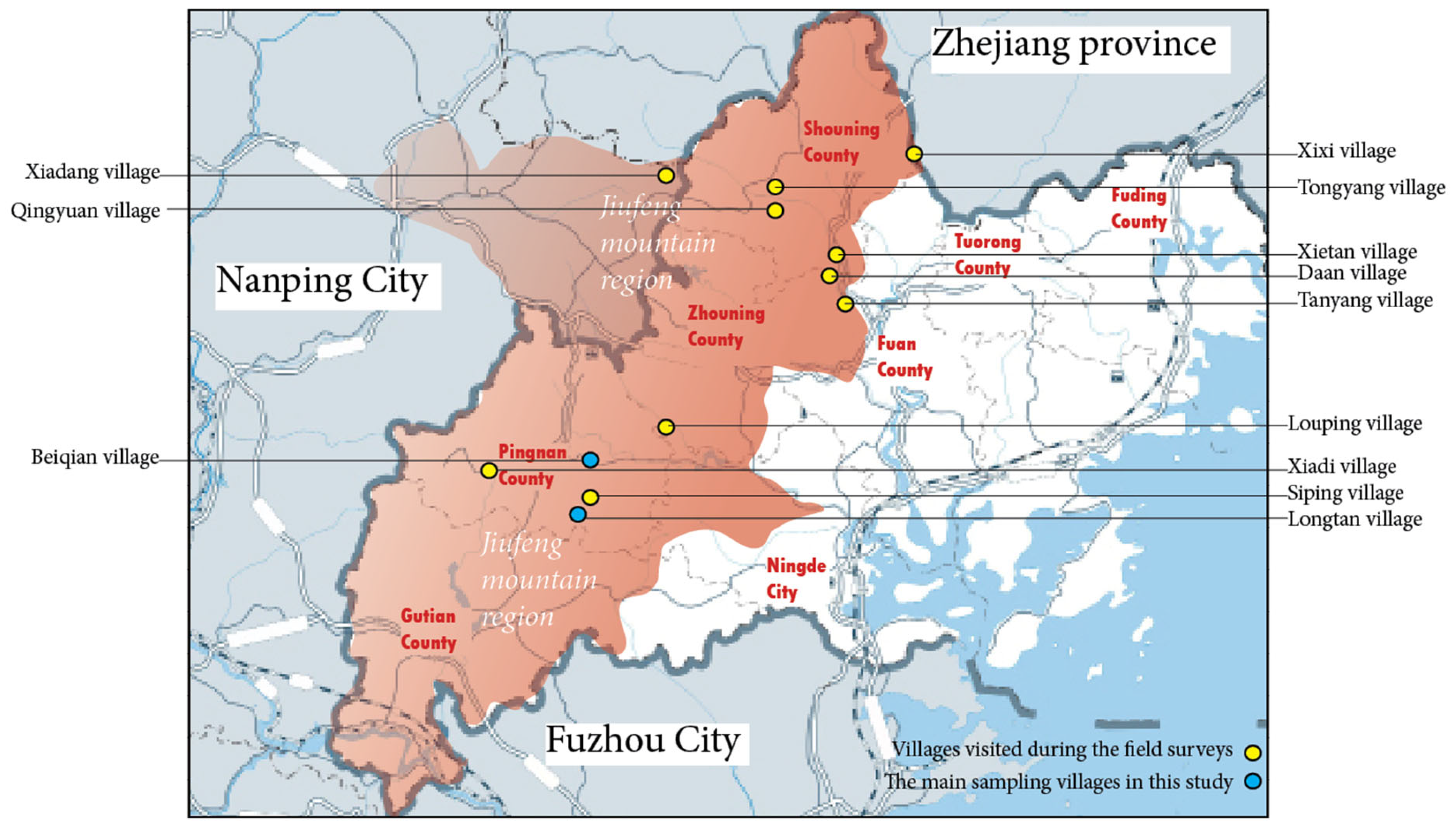
3.1.2. Beiqian Village and Longtan Village
- Both villages are the most well-known tourist destinations in the surrounding area, and they have similar transportation conditions, permanent populations, and levels of tourism development. Although there is a significant difference in the overall area, the core tourism areas are roughly equivalent. Additionally, the original villagers still live in the villages and maintain traditional lifestyles in spite of tourism developing.
- The two villages have distinct differences in their tourism development paths. By selecting these two villages as the research subjects, it is possible to first conduct a correlational analysis between the evaluation results and the actual situations in each village. Secondly, a comparative analysis of the evaluation results from the two villages can be performed to effectively test the feasibility of the evaluation method.
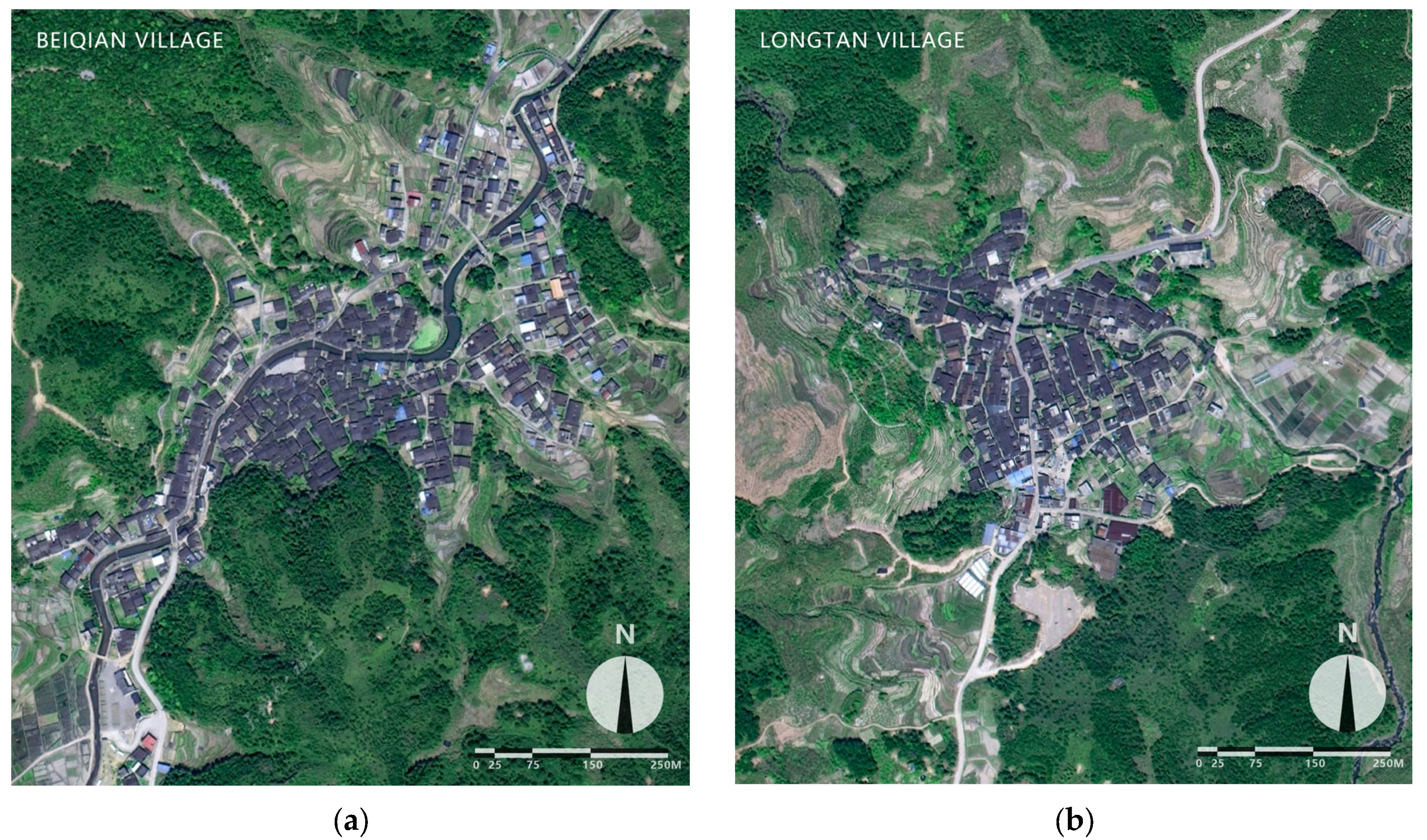
| Information | Beiqian Village | Longtan Village |
|---|---|---|
| Location | Daixi Town, Pingnan County, Fujian Province | Xiling Town, Pingnan County, Fujian Province |
| Distance from the city 1 | 42 km, 60-min drive | 36 km, 50-min drive |
| Registered population | 2268 | 1174 |
| Permanent population | 1280 | 814 |
| Total area | 28 km2 | 5.6 km2 |
| Built-up area | 67 hectares | 12 hectares |
| Tourism area | 15 hectares | 11 hectares |
| Honorary title | The third batch of Traditional Chinese Villages (2014) | The sixth batch of Traditional Chinese Villages (2023) |
| Formation time | Early 14th century | Early 15th century |
| Start of tourism development | 2016 | 2017 |
| Main industry | Yellow wine and cultural tourism | Cultural and creative industries |
| Development model | Government financial support and university cooperation | Government as the lead, with artist guidance and villagers’ participation |
| Innovative policy | / | “15-year-lease subscription of old house”, “labor and material law”, and “Longtan green card” |
| Tourism in 2022 | Tourists: over 40,000 Income: over CNY 0.6 million | tourists: over 300,000 Income: over CNY 13 million |
| PCDI 2 in 2022 | CNY 23,000 | CNY 24,800 |
| Other non-agricultural industry | Yellow wine: over 1000 tons per year Income: over CNY 30 million | / |
3.2. Existing Evaluation System of Villager Satisfaction for Rural Human Settlements
3.3. Exploration of Evaluation Indicators Based on Field Surveys
- Increase indicators related to social relationship satisfaction. The secondary indicators are refined according to the five groups of indigenous villagers, new villagers, tourists, government personnel, and village committee and village officials. Such indicators can not only directly reflect the harmonious degree of interpersonal relationships, but also reflect the fairness of social distribution.
- Increase indicators related to the rural esthetic satisfaction. For the prevalent problem of traditional dwellings’ reconstruction and utilization in the tourism village development, these indicators aim to reflect the social satisfaction of tourism development through the villager satisfaction with the natural landscape, the design of new/rebuilt buildings, and the protection and inheritance of traditional culture. Additionally, the tendency of imitation in the design of newly constructed or renovated structures was incorporated to investigate the social demonstration of tourism development.
- Simplify the relevant indicators for satisfaction with the physical environment construction. Objective evaluations of the physical environment construction generally align with the subjective attitudes of the villagers: as long as the relevant construction meets objective functional standards, villagers are generally satisfied. Therefore, there is no need to collect additional subjective opinions. Thus, only essential factors for mountainous area tourism development, such as road transportation, ecological environment, living conditions, water and electricity, lighting, and communication, were retained.
- Simplify the phraseology and the size of the questionnaire. Due to the relatively low level of education of elderly villagers, the questionnaire should be easy to understand, and the total number of questions should be controlled at 20–30 and completed in 3–5 min to ensure the initiative of villagers and the quality of answers. The questions applied to the questionnaire are shown in Table 4.
4. Data Collection and Result Analysis
4.1. Source of Samples and Reliability and Validity Analyses
4.1.1. Reliability Analysis
4.1.2. Validity Analysis
4.2. Results of the Villager Satisfaction Evaluation
5. Discussion
5.1. Validity Analysis of the Villager Satisfaction Evaluation Method
5.2. The Process of Introducing Villager Satisfaction into the Evaluation Method
5.3. Application Scenarios of the Villager Satisfaction Evaluation Method
6. Conclusions
Author Contributions
Funding
Institutional Review Board Statement
Informed Consent Statement
Data Availability Statement
Conflicts of Interest
References
- Murzyn-Kupisz, M. Cultural, economic and social sustainability of heritage tourism: Issues and challenges. Econ. Environ. Stud. 2012, 12, 113–133. [Google Scholar]
- Murzyn-Kupisz, M.; Działek, J. Cultural heritage in building and enhancing social capital. J. Cult. Herit. Manag. Sustain. Dev. 2013, 3, 35–54. [Google Scholar] [CrossRef]
- Sun, J.; Xu, X.; Wang, N.; Xie, Y.; Ma, B.; Zhang, J.; Yang, Y.; Li, F.; Liao, J.; Weng, S. Approaches and Models of Tourism to Achieve Comprehensive Poverty Alleviation and Rural Revitalization: Expert Insights on “Tourism Poverty Alleviation and Rural Revitalization. J. Nat. Resour. 2021, 36, 2604–2614. [Google Scholar]
- Gao, J.; Wu, B. Revitalizing traditional villages through rural tourism: A case study of Yuanjia Village, Shaanxi Province, China. Tour. Manag. 2017, 63, 223–233. [Google Scholar] [CrossRef]
- Li, P.; Ryan, C.; Cave, J. Chinese rural tourism development: Transition in the case of Qiyunshan, Anhui—2008–2015. Tour. Manag. 2016, 55, 240–260. [Google Scholar] [CrossRef]
- Wu, L.; Research on the Acceleration of the Construction of Public Cultural Service System Research Group. Research on the Protection and Development of Traditional Villages in the Process of Urbanization: An Empirical Study Based on Five Provinces in Central and Western China. Soc. Stud. 2013, 116–123. [Google Scholar]
- Wu, B. Traditional Village Protection and Revitalization Based on Rural Tourism. Soc. Sci. 2016, 7–9. [Google Scholar]
- Lai, K.; Li, Y.; Feng, X. Gap between tourism planning and implementation: A case of China. Tour. Manag. 2006, 27, 1171–1180. [Google Scholar] [CrossRef]
- Che, Z.; Bao, J. Research on the Development and Morphological Changes of Traditional Village Tourism. Planner 2006, 45–60. [Google Scholar]
- Yang, R.; Xu, Q.; Zhou, J.; Chen, Y. Analysis of the Mechanism of Traditional Village Spatial Transformation in Fengjian Village Based on Actor-Network Theory. Sci. Geogr. 2018, 38, 1817–1827. [Google Scholar]
- Kunjuraman, V.; Hussin, R. Stakeholder Involvement in community-based tourism and livelihoods: A case study of Abai village, lower Kinabatangan area of Sabah, Malaysia. In Proceedings of the Social Sciences Postgraduate International Seminar (SSPIS) 2016, Penang, Malaysia, 15 December 2016; p. 55. [Google Scholar]
- Boonwanno, S.; Laeheem, K.; Hunt, B. Takua Pa Old Town: Potential for resource development of community-based cultural tourism management. Kasetsart J. Soc. Sci. 2022, 43, 88–93. [Google Scholar]
- Ghaderi, Z.; Henderson, J.C. Sustainable rural tourism in Iran: A perspective from Hawraman Village. Tour. Manag. Perspect. 2012, 2, 47–54. [Google Scholar] [CrossRef]
- Ladkin, A.; Bertramini, A.M. Collaborative tourism planning: A case study of Cusco, Peru. Curr. Issues Tour. 2002, 5, 71–93. [Google Scholar] [CrossRef]
- Hatipoglu, B.; Alvarez, M.D.; Ertuna, B. Barriers to stakeholder involvement in the planning of sustainable tourism: The case of the Thrace region in Turkey. J. Clean. Product. 2016, 111, 306–317. [Google Scholar] [CrossRef]
- Pilati, M.; Hunter, A. Research for REGI Committee—EU Lagging Regions: State of play and future challenges European Parliament. In Policy Department for Structural and Cohesion Policies; Think Tank: Brussels, Belgium, 2020. [Google Scholar]
- Saxena, G.; Ilbery, B. Developing integrated rural tourism: Actor practices in the English/Welsh border. J. Rural Stud. 2010, 26, 260–271. [Google Scholar] [CrossRef]
- Girard, L.F.; Nijkamp, P. Cultural Tourism and Sustainable Local Development; Ashgate: Farnham, UK, 2009. [Google Scholar]
- Girard, L.F.; Nijkamp, P. Narrow Escapes: Pathways to Sustainable Local Cultural Tourism. In Cultural Tourism and Sustainable Local Development; Routledge: Oxford, UK, 2016; pp. 19–28. [Google Scholar]
- Wu, Z.; Wu, Y.; Shi, W.B. Revitalization of Endogenous Mechanism: Vernacular Synergistic Design Based on Neo-Logic of Vernacular Settlements. Arch. J. 2017, 02, 108–113. [Google Scholar]
- Throsby, D. Tourism, heritage and cultural sustainability: Three ‘golden rules’. In Cultural Tourism and Sustainable Local Development, 1st ed.; Girard, L.F., Nijkamp, P., Eds.; Taylor & Francis: London, UK, 2009; ISBN 978-1-3152-5872-0. [Google Scholar]
- Nie, C. Research on Strategies and Actions for the Conservation of Ancient Villages. Ph.D. Thesis, Minzu University of China, Beijing, China, 2011. [Google Scholar]
- Wanner, A.; Pröbstl-Haider, U. Barriers to Stakeholder Involvement in Sustainable Rural Tourism Development—Experiences from Southeast Europe. Sustainability 2019, 11, 3372. [Google Scholar] [CrossRef]
- Blackstock, K. A critical look at community based tourism. Commun. Dev. J. 2005, 40, 39–49. [Google Scholar] [CrossRef]
- Williams, J.; Lawson, R. Community issues and resident opinions of tourism. Ann. Tour. Res. 2001, 28, 269–290. [Google Scholar] [CrossRef]
- Hwang, D.; Stewart, W.P.; Ko, D.-w. Community behavior and sustainable rural tourism development. J. Travel Res. 2012, 51, 328–341. [Google Scholar] [CrossRef]
- World Commission on Environment and Development. Our Common Future 1987, 17, 1–91.
- Wang, G.; Yang, K.; Mao, Z.Q. Community Building Showing the Potential Value of Country: Japan’s Charming Country Construction Experience. Urban Dev. Stud. 2016, 1, 13–18. [Google Scholar]
- Liu, Y.; Zhang, S.S.; Bao, Z.T. Art Involved Community Creation and Planning. Planners 2016, 8, 29–34. [Google Scholar]
- Inbakaran, R.; Jackson, M. Marketing regional tourism: How better to target and address community attitudes to tourism. J. Vacat. Mark. 2005, 11, 323–339. [Google Scholar] [CrossRef]
- Andereck, K.L.; Vogt, C.A. The Relationship between Residents’ Attitudes toward Tourism and Tourism Development Options. J. Travel Res. 2000, 39, 27–36. [Google Scholar] [CrossRef]
- Ap, J.; Crompton, J.L. Residents’ strategies for responding to tourism impacts. J. Travel Res. 1993, 32, 47–50. [Google Scholar] [CrossRef]
- Tosun, C. Limits to community participation in the tourism development process in developing countries. Tour. Manag. 2000, 21, 613–633. [Google Scholar] [CrossRef]
- Dogra, R.; Gupta, A. Barriers to community participation in tourism development: Empirical evidence from a rural destination. S. Asian J. Tour. Herit. 2012, 5, 129–142. [Google Scholar]
- Kala, D.; Bagri, S. Barriers to local community participation in tourism development: Evidence from mountainous state Uttarakhand, India. Tour. Int. Interdiscip. J. 2018, 66, 318–333. [Google Scholar]
- Knight, D.W.; Cottrell, S.P. Evaluating tourism-linked empowerment in Cuzco, Peru. Ann. Tour. Res. 2016, 56, 32–47. [Google Scholar] [CrossRef]
- McIntosh, R.W.; Goeldner, C.R. Tourism: Principles, Practices, Philosophies; Wiley: New York, NY, USA, 1986. [Google Scholar]
- Davis, D.; Allen, J.; Cosenza, R.M. Segmenting Local Residents by Their Attitudes, Interests, and Opinions Toward Tourism. J. Travel Res. 1988, 27, 2–8. [Google Scholar] [CrossRef]
- Andriotis, K. Residents’ Satisfaction or Dissatisfaction with Public Sector Governance: The Cretan Case. Tour. Hosp. Res. 2002, 4, 53–68. [Google Scholar] [CrossRef]
- Hassan, T.H.; Salem, A.E.; Abdelmoaty, M.A. Impact of Rural Tourism Development on Residents’ Satisfaction with the Local Environment, Socio-Economy and Quality of Life in Al-Ahsa Region, Saudi Arabia. Int. J. Environ. Res. Public Health 2022, 19, 4410. [Google Scholar] [CrossRef] [PubMed]
- Miao, Y.; Zhou, L. Effect of Rural Tourism on Poverty Alleviation and lts lmpact on Villagers’ Satisfaction Under the Strategy of Rural Revitalization. North. Hortic. 2019, 20, 131–139. [Google Scholar]
- Peng, Y. Study on the Villagers’ Satisfaction of the Heritage Protection at Dangjia Village. Hous. Sci. 2016, 8, 33–39. [Google Scholar] [CrossRef]
- Jia, F.; Zhang, R.; Hou, Y. Research on the change and satisfaction of villagers’ living space driven by rural tourism. Rural Sci. Technol. 2020, 1, 10–13. [Google Scholar] [CrossRef]
- Preiser, W. Post-Occupancy Evaluation: How to Make Buildings Work Better; Van Nostrand Reinhold: New York, NY, USA, 1988; ISBN 978-04-4200-345-6. [Google Scholar]
- Zhuang, W. From Architectural Programming to Post Occupancy Evaluation: A Feedback Mechanism of Architectural Procedure Circle. Des. Commun. 2017, 5, 125–129. [Google Scholar]
- Dang, Y.; Zhuang, W. Color Analysis as a Method in Architectural Programming of Rural Construction. Arch. Tech. 2020, 04, 108–112. [Google Scholar]
- Dang, Y. Architectural Planning Method System Architecture for Rural Development. Ph.D. Thesis, Tsinghua University, Beijing, China, 2019. [Google Scholar]
- Shi, Y.; Ye, L. Review and Reflection on the Research Progress of Rural Human Settlements Evaluation System. Dev. Small Cities Towns 2023, 5, 82–91. [Google Scholar]
- Li, X. Application and Thinking of the Theory of “Gesamtkunstwerk” in Contemporary Rural Construction—A Case Study of Longtan Village, Pingnan County, Fujian Province. Master’s Thesis, Central Academy of Fine Arts, Beijing, China, 2021. [Google Scholar] [CrossRef]
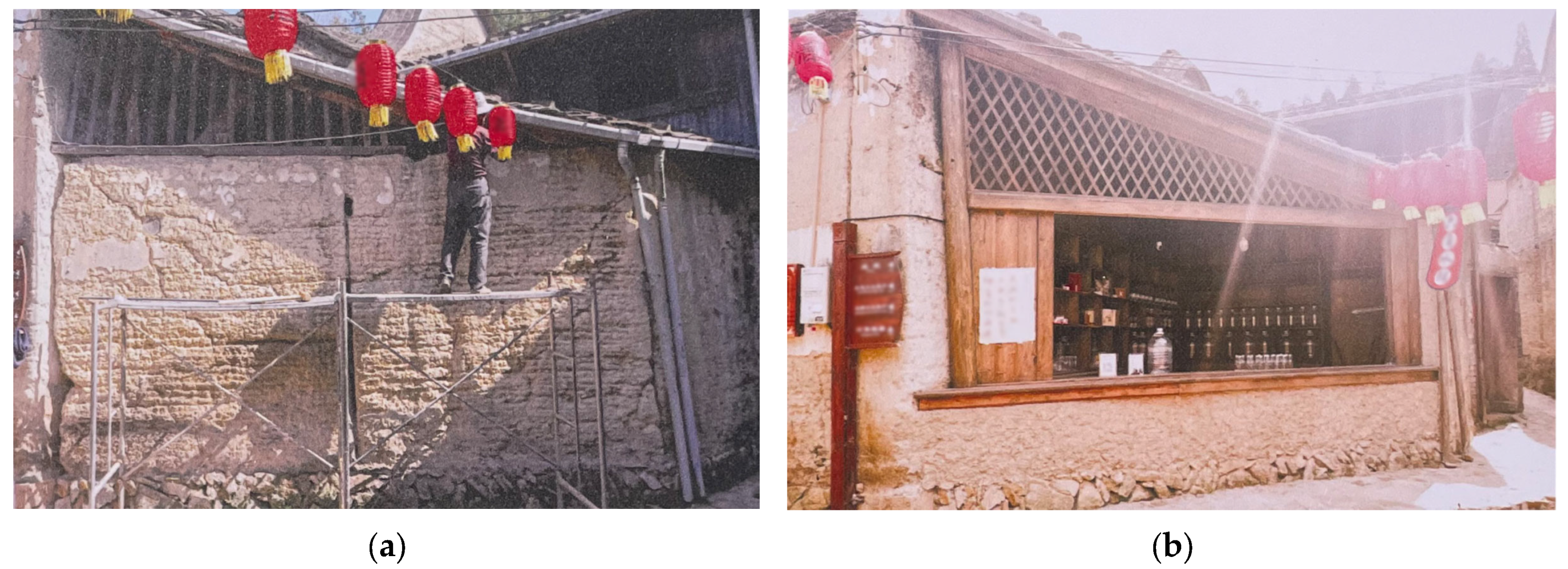
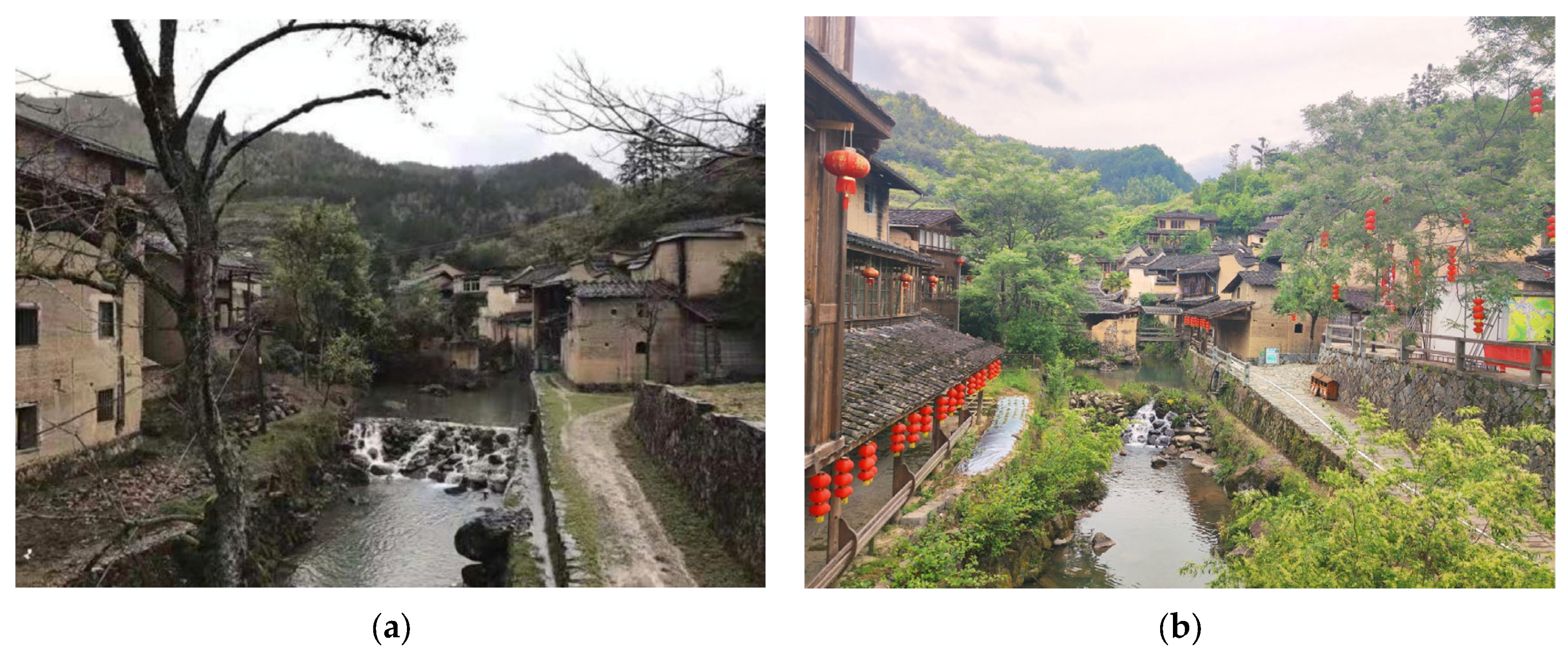
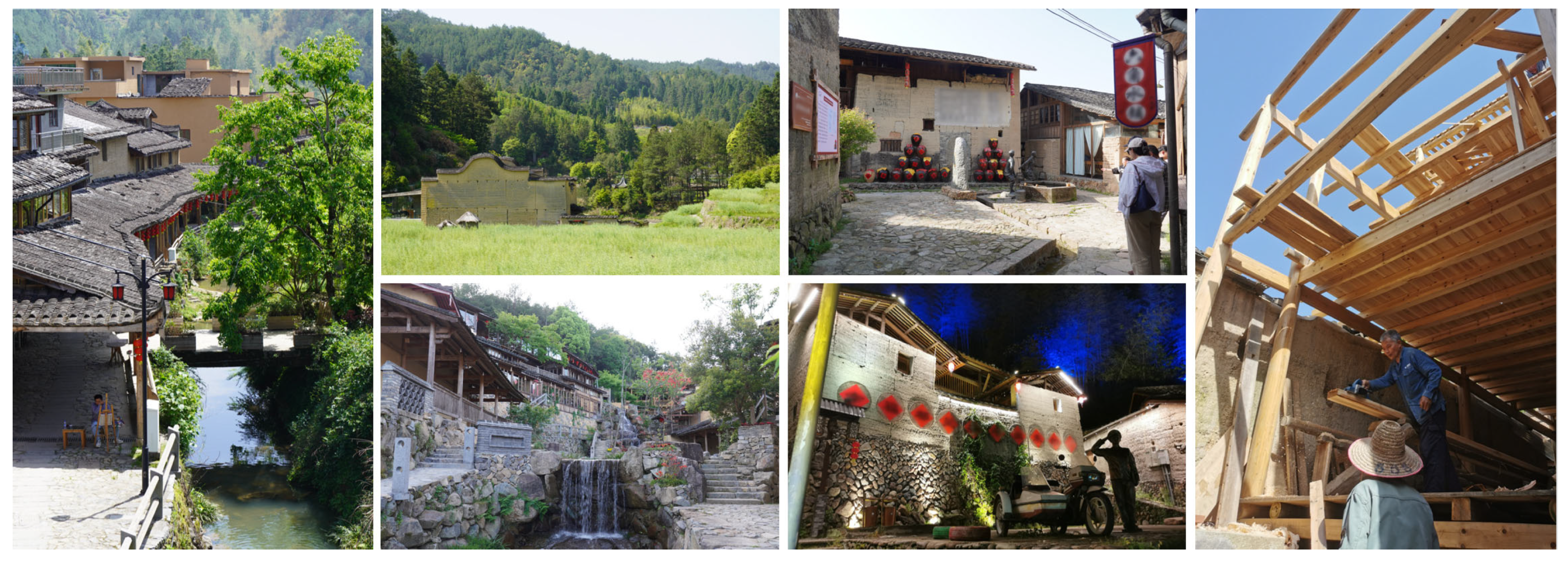
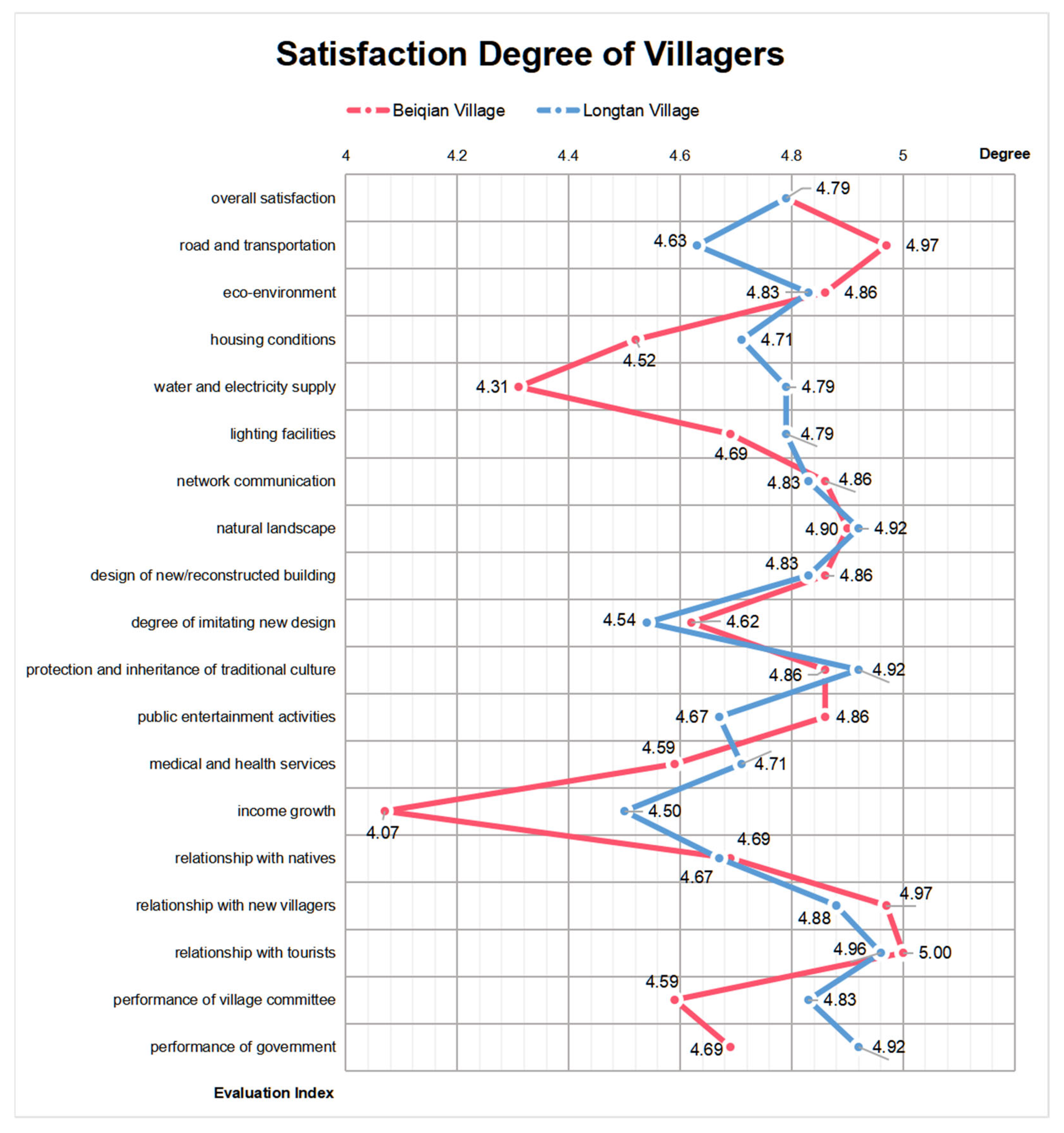
| Primary Indicators | Secondary Indicators |
|---|---|
| Living conditions (6) | Per capita house area |
| Day light and house orientation | |
| Quality of construction | |
| Architecture design | |
| Density of buildings | |
| Courtyard landscape | |
| Infrastructure (6) | Road and transportation |
| Water supply | |
| Traffic convenience | |
| Electricity supply | |
| Waste disposal | |
| Quantity and quality of public toilets | |
| Ecological environment (4) | Air quality |
| Plants and gardening | |
| Sewage disposal | |
| Quality of drinking water | |
| Public services (3) | Shopping convenience |
| Quantity and quality of schools | |
| Recreational facilities | |
| Quality of life (2) | Cultural and sports facilities |
| Children’s access to school | |
| Social circumstance (2) | Social security |
| Health care | |
| Social culture (2) | Neighborhood relationship |
| Quality of democracy | |
| Economic development (1) | Per capita disposable income |
| Type | Interviewee | Identity | Main Subject of Interview |
|---|---|---|---|
| Government officials and local experts | Wan | Fujian Province government | Policy logic of rural tourism development |
| Song | Ningde Tourism Management Association | Application of and support for Traditional Chinese Village | |
| Fa | Pingnan first middle school | Development of rural tourism in Pingnan | |
| Li | Shouning housing and urban–rural development bureau | Rural tourism and inheritance of traditional techniques in Shouning | |
| Ye | Qingyuan Town government | Policy of rural settlement environment improvement | |
| Gong | Qingyuan Town government | Planning of village and rural tourism | |
| Village officials | Wu | Beiqian Village | History and tourism development of each village |
| Chen | Longtan Village | ||
| Gong | Xiadi Village | ||
| Indigenous villagers | A wine seller | Beiqian Village | Experience in Beiqian |
| A middle-aged Worker | |||
| A young entrepreneur | Longtan Village | Personal experience of running a business | |
| A tea maker | Xiadi Village | Motivation of returning to village | |
| An antique dealer | Tongyang Village | founding experience of Tongyang Cultural Park | |
| New villagers | A homestay owner from Ningde | Longtan Village | Motivation of coming to Longtan and running of a homestay business |
| A homestay owner from Fuzhou | |||
| A volunteer | Xiadi Village | Motivation of coming to Xiadi and the circumstances of foreign volunteers | |
| A young porcelain maker | Xiadang Village | Running of traditional craft workshops | |
| A young entrepreneur | Siping Village | Work of rural revitalization workstation |
| Primary Indicator | Secondary Indicator | Questions in the Questionnaire (5-Point Likert Scale) | Corresponding Social Factors |
|---|---|---|---|
| Overall satisfaction (1) | Overall satisfaction with tourism development | Are you generally satisfied with the tourism development of the village in recent years? If not, what are the main reasons for dissatisfaction? | Public participation, public opinion, and social satisfaction |
| Satisfaction with physical environment construction (6) | Road and transportation | How are the road and transportation influenced by the tourism development in your village? | / |
| Eco-environment | How is the ecological environment influenced by the tourism development in your village? | / | |
| Housing conditions | How are the living conditions influenced by the tourism development in your village? | / | |
| Water and electricity supply | Are you satisfied with the village water and electricity supply after the tourism development? | / | |
| Lighting facilities | Are you satisfied with the village lighting facilities after the tourism development? | / | |
| Network communication | Are you satisfied with the village network communication after the tourism development? | / | |
| Rural scene (4) | Natural landscape | Does the natural scenery of the village look better after tourism development? | Public participation, public opinion, and social satisfaction |
| Design of new/reconstructed buildings | Do the buildings in the village look better after tourism development? | Public participation, public opinion, and social satisfaction | |
| Imitation tendency of new/reconstructed design | Is it possible for you to imitate or learn from the new and reconstructed houses when repairing your own house in the future? | Social demonstration | |
| Protection and inheritance of traditional culture | Are you satisfied with the protection and inheritance of traditional culture in the process of tourism development? | Public participation, public opinion, and social satisfaction; social demonstration | |
| Economic and social development (3) | Public entertainment activities | How are the public entertainment activities influenced by the tourism development in your village? | Community relations and social progress |
| Medical and health service | How is the medical and health service influenced by the tourism development in your village? | Community relations and social progress | |
| Income growth | How has your income changed after tourism development? Are you satisfied with the changes? | Community relations and social progress | |
| Social relationship (5) | Relationship with indigenous villagers | How are the relationships among native villagers after the tourism development? | Community relations and social progress; social equity |
| Relationship with new villagers | What is your attitude towards the new villagers during the process of tourism development? | Community relations and social progress; social equity | |
| Relationship with tourist | What is your attitude towards the tourists during the process of tourism development? | Community relations and social progress; social equity | |
| Performance of village committee | What is your attitude towards the village committee during the process of tourism development? | Community relations and social progress; social equity | |
| Performance of government | What is your attitude towards the government during the process of tourism development? | Community relations and social progress; social equity |
| Sample Size | Item | Cronbach |
|---|---|---|
| 58 | 22 | 0.783 |
| Parameter | Value | |
|---|---|---|
| KMO | 0.606 | |
| Bartlett’s test of sphericity | x2 | 1018.061 |
| df | 231 | |
| p | 0.000 | |
| Evaluation Index | Longtan Village (s1) | Beiqian Village (s2) | Degree of Difference (d) 1 |
|---|---|---|---|
| Overall satisfaction | 4.79 | 4.79 | 0.000 |
| Road and transportation | 4.63 | 4.97 | 0.073 |
| Eco-environment | 4.83 | 4.86 | 0.006 |
| Housing conditions | 4.71 | 4.52 | 0.042 |
| Water and electricity supply | 4.79 | 4.31 | 0.111 |
| Lighting facilities | 4.79 | 4.69 | 0.021 |
| Network communication | 4.83 | 4.86 | 0.006 |
| Natural landscape | 4.92 | 4.9 | 0.004 |
| Design of new/reconstructed buildings | 4.83 | 4.86 | 0.006 |
| Degree of imitation for new designs | 4.54 | 4.62 | 0.018 |
| Protection and inheritance of traditional culture | 4.92 | 4.86 | 0.012 |
| Public entertainment activities | 4.67 | 4.86 | 0.041 |
| Medical and health services | 4.71 | 4.59 | 0.026 |
| Income growth | 4.5 | 4.07 | 0.106 |
| Relationship with the natives | 4.67 | 4.69 | 0.004 |
| Relationship with the new villagers | 4.88 | 4.97 | 0.018 |
| Relationship with tourists | 4.96 | 5 | 0.008 |
| Performance of the village committee | 4.83 | 4.59 | 0.052 |
| Performance of the government | 4.92 | 4.69 | 0.049 |
Disclaimer/Publisher’s Note: The statements, opinions and data contained in all publications are solely those of the individual author(s) and contributor(s) and not of MDPI and/or the editor(s). MDPI and/or the editor(s) disclaim responsibility for any injury to people or property resulting from any ideas, methods, instructions or products referred to in the content. |
© 2023 by the authors. Licensee MDPI, Basel, Switzerland. This article is an open access article distributed under the terms and conditions of the Creative Commons Attribution (CC BY) license (https://creativecommons.org/licenses/by/4.0/).
Share and Cite
Liu, N.; Yue, K.; Zhang, X. Ignored Opinions: Villager-Satisfaction-Based Evaluation Method of Tourism Village Development—A Case Study of Two Villages in China. Sustainability 2023, 15, 15726. https://doi.org/10.3390/su152215726
Liu N, Yue K, Zhang X. Ignored Opinions: Villager-Satisfaction-Based Evaluation Method of Tourism Village Development—A Case Study of Two Villages in China. Sustainability. 2023; 15(22):15726. https://doi.org/10.3390/su152215726
Chicago/Turabian StyleLiu, Naifei, Kaijian Yue, and Xiaoyue Zhang. 2023. "Ignored Opinions: Villager-Satisfaction-Based Evaluation Method of Tourism Village Development—A Case Study of Two Villages in China" Sustainability 15, no. 22: 15726. https://doi.org/10.3390/su152215726
APA StyleLiu, N., Yue, K., & Zhang, X. (2023). Ignored Opinions: Villager-Satisfaction-Based Evaluation Method of Tourism Village Development—A Case Study of Two Villages in China. Sustainability, 15(22), 15726. https://doi.org/10.3390/su152215726






